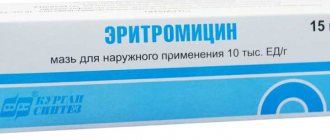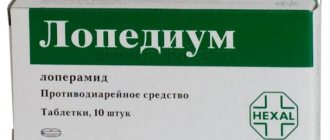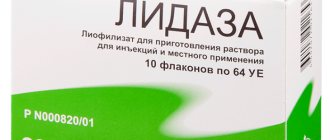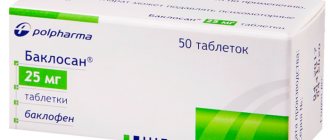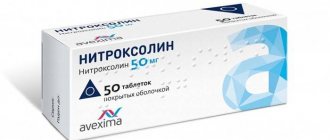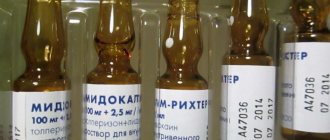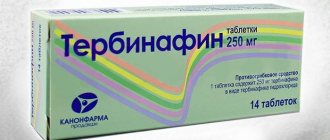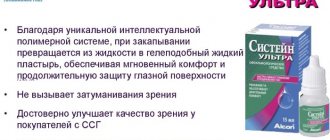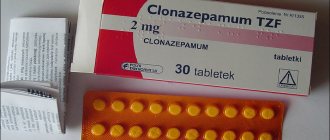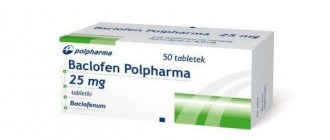1116
Author of the article
Evgeniy Nikolaevich Konoplev
Reading time: 7 minutes
AA
The drug Mikoflucan is a broad-spectrum drug intended for the treatment and prevention of fungal infections. Tablets have many undesirable effects, relative and absolute contraindications. Therefore, they must be taken with caution, in strict accordance with the requirements of the annotation attached to them.
Pharmacodynamics and pharmacokinetics
Pharmacodynamics
It has a highly specific effect on fungi, blocking the cytochrome P450 enzyme system. Violation of membrane biosynthesis explains the fungistatic effect . At higher concentrations, the death of the fungal cell is observed, that is, a fungicidal effect . Practically does not inhibit cytochrome enzymes in humans. Does not have an antiadrogenic effect. Active against mycoses caused by Candida spp. , Microsporum spp. , Coccidioides immitis , Trichophyton spp. , with endemic mycoses .
Pharmacokinetics
Well absorbed from the gastrointestinal tract. Tmax is determined after 1-1.5 hours. Concentration in the blood depends on the dose. The equilibrium concentration is determined after 5 days. When taking a “shock” dose, this concentration is achieved by day 2. The drug penetrates well into various body fluids. In sputum, peritoneal and joint fluid, saliva, and breast milk, the concentration is similar to that in plasma. The concentration in the cerebrospinal fluid is 85% of the concentration in plasma. In vaginal secretions, the required concentration is determined after 8 hours and is maintained for a day. Selective accumulation is observed in the stratum corneum and dermis. The half-life is 30 hours. The pharmacokinetics of fluconazole depends on the condition of the kidneys.
Composition and pharmacological properties
The main active ingredient of Mycoflucan tablets is fluconazole. This compound has been proven to:
- suppresses the activity of fungal enzymes associated with cytochrome P450, without inhibiting the production of similar compounds in the human body;
- slows down the transition of lanosterol, present in the pathogen cells, into ergosterol;
- increases the permeability of fungal cell membranes, disrupting the processes of their reproduction and growth.
The described properties of fluconazole allow the use of Mycoflucan in the treatment of a wide range of opportunistic mycoses. The drug is active against fungi belonging to the genera Microsporum, Cryptococcus neoformans, Candida, Histoplasma capsulatum, Trichophyton, Blastomyces dermatitidis and Coccidioides immitis.
In addition to fluconazole, the drug contains a number of auxiliary components. These include colloidal silicon dioxide, purified talc, lactose, povidone K30, microcrystalline cellulose, magnesium stearate and croscarmellose sodium.
Indications for use
- generalized candidiasis in patients receiving cytostatic or immunosuppressive therapy (treatment and prevention);
- systemic lesions by Cryptococcus fungi ( meningitis , sepsis , damage to the lungs and skin in patients with immunosuppression );
- mucosal candidiasis;
- mycoses of the skin and nails;
- genital candidiasis (treatment and prevention);
- endemic mycoses ( sporotrichosis , coccidioidomycosis , paracoccidioidomycosis and histoplasmosis ).
Side effects
As a rule, Mycoflucan in any dosage form is well tolerated.
However, during therapy the following side effects may develop:
- Cardiovascular system: rarely - ventricular flutter/fibrillation, increased duration of the QT interval;
- Digestive system: uncommon – abdominal pain, nausea, flatulence, diarrhea, vomiting, change in taste; rarely - functional liver disorders (jaundice, hyperbilirubinemia, increased activity of aspartate aminotransferase, alanine aminotransferase and alkaline phosphatase, hepatocellular necrosis, hepatitis), incl. with fatal outcome;
- Central nervous system: infrequently – dizziness, headache; rarely – convulsions;
- Hematopoietic organs: rarely - agranulocytosis, thrombocytopenia, leukopenia, neutropenia;
- Allergic reactions: infrequently - skin rash; rarely - toxic epidermal necrolysis (Lyell's syndrome), exudative erythema multiforme (including Stevens-Johnson syndrome), anaphylactoid reactions (including urticaria, angioedema, pruritus, facial edema);
- Other: rarely - alopecia, renal dysfunction, hypokalemia, hypercholesterolemia, hypertriglyceridemia.
Mikoflucan, instructions for use (Method and dosage)
The dose of the drug depends on the severity of the fungal infection. Usually adults are prescribed:
- for oropharyngeal candidiasis Mikoflucan 150 mg 1 time/day for 7-14 days;
- for cryptococcal meningitis on the 1st day 400 mg, and with the transition to 200 1 time per day. Treatment lasts 6-8 weeks;
- for disseminated candidiasis and candidemia , 400 mg on the first day with a transition to 200 mg/day;
- for atrophic candidiasis of the oral mucosa , which is associated with wearing dentures, 50 mg once a day, 2 weeks;
- for vaginal candidiasis, 150 mg once;
- for esophagitis , candidiasis of the skin and mucous membranes , candiduria 150 mg/day. 14-30 days;
- for mycoses of the skin of the feet 150 mg once a week, month;
- for onychomycosis (nail damage) 150 mg once a week until replacement with a healthy nail, usually from 3 to 12 months.
General characteristics of the medicine
The drug Mycoflucan is produced by the Indian pharmaceutical company Dr. Reddy's Laboratories Ltd. The medicine is white flat-cylindrical tablets with a bevel, containing 150 or 50 mg of the active substance and packaged in blister packs made of polyvinyl chloride and aluminum foil (1 and 7 pieces, respectively). The drug goes on sale in cardboard packs. In each of them, the manufacturer includes a blister of tablets and detailed instructions for their use.
The medicine can be purchased at a pharmacy without a prescription. The selling price for Mikoflucan depends on the type and number of tablets in the package and varies from 170 to 450 rubles. The drug should be stored in a dry place, out of reach of children and well protected from direct sunlight. In this case, you need to ensure that the medicine is not heated to a temperature of 25 °C or higher.
Subject to all storage conditions specified by the manufacturer, the pharmaceutical and organoleptic properties of Mycoflucan remain unchanged for 36 months.
It is strictly forbidden to take tablets after the expiration date indicated on the blister and cardboard packaging.
Interaction
- The drug enhances the effect of coumarin anticoagulants ( Warfarin ).
- When taken concomitantly with sulfonylureas, their half-life is prolonged, causing hypoglycemia .
- Administration with Phenytoin leads to an increase in its serum concentration.
- Increases the concentration of midozalam (risk of developing psychomotor reactions), tacrolimus (risk of nephrotoxicity), zidovudine (its side effects increase).
- Repeated use of fluconazole in a dose of up to 200 mg does not affect the effectiveness of contraceptives.
- Use with Rifampicin leads to a decrease in the total concentration of fluconazole.
- Concomitant use with Terfenadine .
- When taken simultaneously with Cisapride, cardiac reactions are possible.
Contraindications and side effects
In most cases, adults and children tolerate Mycoflucan therapy well. Side effects of the drug occur infrequently. These include:
- allergic reactions - erythema, itching, urticaria, facial swelling, etc.;
- dizziness and headaches;
- nausea, urge to vomit;
- flatulence;
- taste disturbance;
- abdominal pain;
- convulsions;
- diarrhea;
- heart rhythm disturbance;
- baldness;
- a sharp decrease in the number of platelets, leukocytes and neutrophils in the blood;
- abnormal increase in the concentration of lipoproteins, triglycerides, potassium or lipids in the body.
Contraindications to the prescription of Mikoflucan are hypersensitivity to the components included in its composition, lactation period and simultaneous therapy with terfenadine or astemizole. The medicine is used with caution during pregnancy, liver dysfunction and cardiac diseases accompanied by changes in heart rhythm. In addition, the manufacturer advises patients to be careful when taking Mycoflucan simultaneously with substances that are metabolized by the cytochrome P450 system.
If the recommended doses of the drug are exceeded, the patient may experience hallucinations and a tendency to paranoid behavior.
In such cases, doctors carry out symptomatic therapy, including gastric lavage, diuretic drugs and hemodialysis.
Analogues of Mikoflucan
Level 4 ATC code matches: Medoflucon
Vfend
Itracon
Mikosist
Irunin
Mikomax
Orungal
Fluconazole
Sporagal
Orungamin
Flucostat
Difluzol
Rumicosis
Futsis
Vero-Fluconazole
Kandizol
Kanditral
Itraconazole
Diflazon
Fluconazole Teva , Flucostat , Fucis , Mikomax , Mikosist , Diflucan , Diflazon .
Mycoflucan TB. 150 mg. №1 25954
Description
Tablets: white or off-white, round, flat, beveled tablets with an “F” imprint on one side and “50” or “150” on the other.
Solution for infusion: clear, colorless liquid, free of visible particles.
After oral administration, fluconazole is well absorbed, its plasma levels (and relative bioavailability) exceed 90% of fluconazole plasma levels when administered intravenously. Concomitant food intake does not affect the absorption of the drug taken orally. Cmax in plasma reaches its peak 0.5–1.5 hours after administration, T1/2 of fluconazole is about 30 hours. Cmax in plasma is directly proportional to the dose. By the 4th–5th day of treatment with the drug (when taken once a day), a 90% equilibrium concentration level is achieved.
Administration of a loading dose (on the first day), 2 times higher than the usual daily dose, allows one to achieve drug levels in plasma that approach 90% of equilibrium concentrations by the second day. The apparent volume of distribution approximates the total body water content. Plasma protein binding is 11–12%.
Fluconazole penetrates well into all biological fluids and tissues of the body. Concentrations of the drug in saliva and sputum are similar to its levels in plasma. In patients with fungal meningitis, the fluconazole content in the cerebrospinal fluid reaches 80% of its plasma level. In the stratum corneum, epidermis, dermis and sweat fluid, high concentrations are reached that exceed serum concentrations. Fluconazole is excreted primarily by the kidneys; in this case, approximately 80% of the administered dose is excreted unchanged in the urine. Fluconazole clearance is proportional to creatinine Cl. No fluconazole metabolites were detected in peripheral blood.
Fluconazole, a representative of the class of triazole antifungal agents, is a powerful selective inhibitor of sterol synthesis in fungal cells.
The drug is effective against opportunistic mycoses, incl. caused by Candida spp., Cryptococcus neoformans, Microsporum spp., Trichophyton spp. Fluconazole has also been shown to be active in models of endemic mycoses, including infections caused by Blastomyces dermatitidis, Coccidioides immitis and Histoplasma capsulatum.
In rare cases, the use of fluconazole was accompanied by toxic changes in the liver, incl. with a fatal outcome, mainly in patients with serious concomitant diseases. In the case of hepatotoxic effects associated with fluconazole, there was no obvious dependence on the total daily dose, duration of therapy, gender and age of the patient. The hepatotoxic effects of fluconazole were usually reversible; its signs disappeared after cessation of therapy. If clinical signs of liver damage that may be associated with fluconazole appear, the drug should be discontinued.
People with AIDS are more likely to develop severe skin reactions when taking many drugs. In cases where a rash develops in patients with a superficial fungal infection and is assessed as definitely related to fluconazole, the drug should be discontinued. If a rash appears in patients with invasive/systemic fungal infections, they should be carefully monitored and fluconazole should be discontinued if bullous changes or erythema multiforme occur.
Caution should be exercised when taking fluconazole concomitantly with cisapride, astemizole, rifabutin, tacrolimus or other drugs metabolized by the cytochrome P450 system.
Compound
Tablets 1 tablet. fluconazole 50 mg 150 mg excipients: MCC; lactose; croscarmellose sodium; povidone K30; colloidal silicon dioxide; magnesium stearate; purified talc
in a blister 1 or 4 pcs.; 1 blister in a cardboard pack.
Solution for infusion 100 ml fluconazole 200 mg excipients: sodium chloride; water for injections
in low density PE bottles of 100 ml; 1 bottle in a cardboard pack.
Application
cryptococcosis, including cryptococcal meningitis and other localizations of this infection (including lungs, skin), both in patients with a normal immune response and in patients with various forms of immunosuppression (including AIDS patients, organ transplants ); the drug can be used as a means of maintenance therapy for the prevention of cryptococcal infection in patients with AIDS;
generalized candidiasis, including candidemia, disseminated candidiasis and other forms of invasive candidal infections (infections of the peritoneum, endocardium, eyes, respiratory and urinary tract). Treatment can be carried out in patients with malignant neoplasms, patients in intensive care units, patients undergoing cytostatic or immunosuppressive therapy, as well as in the presence of other factors predisposing to the development of candidiasis;
candidiasis of the mucous membranes, incl. oral cavity and pharynx, esophagus, non-invasive bronchopulmonary candidiasis, candiduria, candidiasis of the skin and mucous membranes, as well as atrophic candidiasis of the oral cavity associated with wearing dentures (treatment can be carried out in patients with normal or reduced immune function); prevention of relapse of oropharyngeal candidiasis in patients with AIDS;
genital candidiasis: vaginal candidiasis (acute and chronic recurrent), prophylactic use to reduce the frequency of relapses of vaginal candidiasis (3 or more episodes per year); candidal balanitis;
prevention of fungal infections in patients with malignant neoplasms who are predisposed to such infections as a result of chemotherapy with cytostatics or radiation therapy;
mycoses of the skin, including mycoses of the feet, body, and groin area; pityriasis versicolor; onychomycosis; skin candidiasis;
deep endemic mycoses, including coccidioidomycosis, paracoccidioidomycosis, sporotrichosis and histoplasmosis in patients with normal immunity.
The use of the drug in pregnant women is not advisable, except in cases of severe, generalized or life-threatening forms of fungal infections, if the expected effect exceeds the possible risk to the fetus. Fluconazole is found in breast milk in the same concentrations as in the blood, so its use in women who are breastfeeding is not recommended.
From the gastrointestinal tract: often - nausea, abdominal pain, diarrhea, flatulence.
Dermatological reactions: often - skin rash.
From the side of the central nervous system: headache.
Some patients, especially those with diseases such as AIDS or malignant neoplasms, may experience changes in blood counts and impaired liver and kidney function during treatment with fluconazole.
Exfoliative skin diseases (Stevens-Johnson syndrome and toxic epidermal necrolysis), seizures, leukopenia, thrombocytopenia and alopecia may occur.
In rare cases, anaphylactic reactions occur, as with other azoles.
When fluconazole is used with warfarin, the PT increases (by an average of 12%). In this regard, it is recommended to carefully monitor PT parameters in patients receiving the drug in combination with coumarin anticoagulants.
Fluconazole increases plasma T1/2 of oral hypoglycemic agents - sulfonylurea derivatives (chloropropanide, glibenclamide, glipizide, tolbutamide) in healthy people. The combined use of fluconazole and oral hypoglycemic agents in patients with diabetes is allowed, but the doctor must keep in mind the possibility of developing hypoglycemia.
Concomitant use of fluconazole and phenytoin may lead to an increase in plasma phenytoin concentrations to a clinically significant extent. Therefore, if it is necessary to use these drugs together, it is necessary to monitor phenytoin concentrations with dose adjustment in order to maintain drug levels within the therapeutic interval.
The combination with rifampicin leads to a decrease in AUC by 25% and a shortening of T1/2 of fluconazole from plasma by 20%. Therefore, in patients receiving rifampicin at the same time, it is advisable to increase the dose of fluconazole.
It is recommended to monitor the concentration of cyclosporine in the blood in patients receiving fluconazole, because the use of fluconazole and cyclosporine in patients with a kidney transplant at a dose of 200 mg/day leads to a slow increase in the concentration of cyclosporine in plasma.
Patients who receive high doses of theophylline or who are at risk of developing theophylline toxicity should be monitored for early detection of symptoms of theophylline overdose, because taking fluconazole leads to a decrease in the average rate of clearance of theophylline from plasma.
With the simultaneous use of fluconazole and cisapride, cases of adverse reactions from the heart, including paroxysms of ventricular tachycardia (torsades de points), have been described.
There are reports of interaction between fluconazole and rifabutin, accompanied by an increase in serum levels of the latter. Cases of uveitis have been described with the simultaneous use of fluconazole and rifabutin. Patients receiving rifabutin and fluconazole simultaneously should be carefully monitored.
Cases of nephrotoxicity have been reported with the simultaneous use of fluconazole and tacrolimus. Patients receiving tacrolimus and fluconazole simultaneously should be carefully monitored.
In patients receiving a combination of fluconazole and zidovudine, an increase in the concentration of zidovudine is observed, which is caused by a decrease in the conversion of the latter to its main metabolite, so an increase in the side effects of zidovudine should be expected.
Terfenadine and astemizole: Given the occurrence of serious, life-threatening arrhythmias in patients receiving azole antifungals in combination with terfenadine or astemizole, their combined use is contraindicated.
Inside, intravenously (in the form of infusions).
Pills
Orally, the daily dose of fluconazole depends on the nature and severity of the fungal infection.
Adults and children over 15 years of age (weighing more than 50 kg)
For cryptococcal meningitis and cryptococcal infections of other localizations, 400 mg of fluconazole is usually prescribed on the first day, and then treatment is continued at a dose of 200–400 mg once a day. The duration of treatment for cryptococcal infections depends on clinical effectiveness confirmed by mycological examination; for cryptococcal meningitis, it is usually continued for a minimum of 6–8 weeks.
To prevent relapse of cryptococcal meningitis in patients with AIDS, after completing the full course of primary treatment, fluconazole therapy is continued at a dose of 200 mg/day for a long period of time.
For candidemia, disseminated candidiasis and other invasive candidal infections, the dose is usually 400 mg on the first day, and then 200 mg/day. If clinical effectiveness is insufficient, the dose of fluconazole can be increased to 400 mg/day. The duration of therapy depends on clinical effectiveness.
For oropharyngeal candidiasis, fluconazole is usually prescribed 150 mg once a day for 7–14 days. If necessary, in patients with a pronounced decrease in immunity, treatment may be longer.
To prevent relapses of oropharyngeal candidiasis in patients with AIDS, after completing the full course of primary therapy, fluconazole can be prescribed 150 mg once a week.
For atrophic oral candidiasis associated with wearing dentures, fluconazole is usually prescribed 50 mg once a day for 14 days in combination with local antiseptics for the treatment of the denture.
For other localizations of candidiasis (except for genital candidiasis), for example, esophagitis, non-invasive bronchopulmonary lesions, candiduria, candidiasis of the skin and mucous membranes, the effective dose of fluconazole is 150 mg/day with a treatment duration of 14–30 days.
For vaginal candidiasis, fluconazole is taken once at a dose of 150 mg. To reduce the frequency of relapses of vaginal candidiasis, the drug can be used at a dose of 150 mg once a month. The duration of therapy is determined individually; it varies from 4 to 12 months. Some patients may require more frequent use of fluconazole.
For balanitis caused by Candida, fluconazole is prescribed as a single dose of 150 mg.
For the prevention of candidiasis, the recommended dose is 50–400 mg 1 time per day, depending on the degree of risk of developing a fungal infection. If there is a high risk of generalized infection, for example in patients with expected severe or long-lasting neutropenia, the recommended dose is 400 mg 1 time per day. The drug is prescribed several days before the expected onset of neutropenia; after the number of neutrophils increases to more than 1000/μl, treatment is continued for another 7 days.
For mycoses of the skin, including mycoses of the feet, smooth skin and skin of the groin area, the recommended dose is 150 mg once a week or 50 mg once a day. The duration of therapy in normal cases is 2–4 weeks, however, with mycoses of the feet, longer therapy (up to 6 weeks) may be required.
For pityriasis versicolor, the recommended dose is 300 mg once a week for 2 weeks (2 doses). Some patients require a third dose of 300 mg per week, while in some cases a single dose of 300–400 mg is sufficient.
An alternative treatment regimen is to use the drug 50 mg once a day for 2–4 weeks.
For onychomycosis, the recommended dose of fluconazole is 150 mg once a week. Treatment should be continued until the infected nail is replaced (the uninfected nail regrows). Fingernails and toenails normally take 3–6 and 6–12 months to re-grow, respectively. However, growth rate can vary widely between individuals and also depending on age.
For deep endemic mycoses, it may be necessary to use the drug at a dose of 200–400 mg/day for up to 2 years. The duration of therapy is determined individually; it can be 11–24 months for coccidioidomycosis; 2–17 months - for paracoccidioidomycosis; 1–16 months for sporotrichosis and 3–17 months for histoplasmosis.
Children
In children, as with similar infections in adults, the duration of treatment depends on the clinical and mycological effect. In children, the drug should not be used in a daily dose that would exceed that in adults, i.e. no more than 400 mg/day. The drug is used daily, once a day.
For esophageal candidiasis in children, fluconazole is prescribed once at a daily dose of 3 mg/kg, in the following average doses: at the age of 3-6 years (body weight 15-20 kg) - 50 mg; at the age of 7–9 years (body weight 21–29 kg) - 50–100 mg; at the age of 10–12 years (body weight 30–40 kg) - 100–150 mg; at the age of 12–15 years (body weight 40–50 kg) – 100–150 mg. The duration of therapy is at least 3 weeks and another 2 weeks after symptom regression.
For candidiasis of the mucous membranes in children, fluconazole is prescribed once in a daily dose of 3 mg/kg, in the following average doses: at the age of 3–6 years (body weight 15–20 kg) - on the 1st day 100–150 mg, then 50 mg; at the age of 7–9 years (body weight 21–29 kg) - on the 1st day 100–200 mg, then 100 mg; at the age of 10–12 years (body weight 30–40 kg) - on the 1st day 100–150 mg, then 50–100 mg; at the age of 12–15 years (body weight 40–50 kg) - on the 1st day 250–300 mg, then 100–150 mg. The duration of therapy is at least 3 weeks.
For generalized candidiasis and cryptococcal infection (including meningitis) in children, fluconazole is prescribed once in a daily dose of 6–12 mg/kg, in the following average doses: at the age of 3–6 years (body weight 15–20 kg) - 100 –250 mg; at the age of 7–9 years (body weight 21–29 kg) - 100–300 mg; at the age of 10–12 years (body weight 30–40 kg) - 200–350 mg; at the age of 12–15 years (body weight 40–50 kg) – 250–400 mg. The duration of therapy is 10–12 weeks (until laboratory confirmation of the absence of pathogens in the cerebrospinal fluid).
For the prevention of fungal infections in children with reduced immunity, in whom the risk of developing infection is associated with neutropenia developing as a result of cytotoxic chemotherapy or radiation therapy, fluconazole is prescribed once in a daily dose of 3–12 mg/kg, in the following average doses: at the age of 3– 6 years (body weight 15–20 kg) – 50–250 mg; at the age of 7–9 years (body weight 21–29 kg) - 50–300 mg; at the age of 10–12 years (body weight 30–40 kg) - 100–350 mg; at the age of 12–15 years (body weight 40–50 kg) - 100–400 mg. The duration of therapy is until the induced neutropenia is eliminated.
In children with impaired renal function, the daily dose of the drug should be reduced (in the same proportion as in adults) in accordance with the severity of renal failure.
Special patient groups
Use in the elderly. In the absence of renal dysfunction, the usual dosage regimen of the drug should be followed. In patients with renal failure (creatinine clearance less than 50 ml/min), the dosage regimen should be adjusted as follows.
Use of the drug in patients with impaired renal function. Fluconazole is excreted mainly in the urine unchanged. When taken once, no dose change is required. When re-prescribing the drug to patients with impaired renal function, a loading dose of 50 to 400 mg should first be administered; when creatinine Cl >40 ml/min, fluconazole is used once a day at the usual dose; when creatinine Cl = 21–40 ml/min - at intervals of 48 hours (once every 2 days) or once a day at 1/2 the usual daily dose; when creatinine Cl = 10–20 ml/min - at intervals of 72 hours (once every 3 days) or once a day at a daily dose equal to 1/3 of the calculated dose. For patients regularly on dialysis, 1 dose of the drug is administered after each hemodialysis session.
Solution for infusion
IV, at a rate of no more than 200 mg/h. The daily dose of fluconazole depends on the nature and severity of the fungal infection. When converting from intravenous administration to taking tablets and vice versa, there is no need to change the daily dose.
The solution for infusion is compatible with 20% glucose solution, Ringer's solution, Hartmann's solution, potassium chloride solution in glucose, 4.2% sodium bicarbonate solution, 0.9% sodium chloride solution. Infusions can be given using conventional transfusion sets using one of the diluents listed above.
Treatment can be started pending results of cultures and other laboratory tests. However, therapy will need to be modified accordingly when the results of these studies become known.
Adults
For cryptococcal meningitis and cryptococcal infections of other localizations, 400 mg of fluconazole is usually prescribed on the first day, and then treatment is continued at a dose of 200–400 mg once a day. The duration of treatment for cryptococcal infections depends on clinical effectiveness confirmed by mycological examination; for cryptococcal meningitis, it is usually continued for at least 6–8 weeks.
To prevent relapse of cryptococcal meningitis in patients with AIDS, after completing the full course of primary treatment, therapy with fluconazole at a dose of 200 mg/day can be continued for a long period of time (switching to the oral form is possible).
For candidemia, disseminated candidiasis and other invasive candidal infections, the dose is on average 400 mg on the first day, and then 200 mg/day. If clinical effectiveness is insufficient, the dose may be increased to 400 mg/day. The duration of therapy depends on clinical effectiveness.
For the prevention of candidiasis in the presence of a high risk of generalized infection, for example in patients with severe or long-term neutropenia, the recommended dose is 400 mg 1 time per day. Fluconazole is prescribed several days before the expected onset of neutropenia and after the number of neutrophils increases to more than 1000/μl, treatment is continued for another 7 days.
For deep endemic mycoses, it may be necessary to use the drug at a dose of 200–400 mg/day for up to 2 years. The duration of therapy is determined individually; for coccidioidomycosis it is 11-24 months, paracoccidioidomycosis - 2-17 months, sporotrichosis - 1-16 months and histoplasmosis - 3-17 months (switching to the oral form is possible).
Children
In children, as with similar infections in adults, the duration of treatment depends on the clinical and mycological effect. In children, the drug should not be used in a daily dose that would exceed that in adults, i.e. no more than 400 mg/day. The drug is used daily, once a day. If long-term therapy is necessary, it is possible to switch to the oral form of fluconazole.
For cryptococcal meningitis and cryptococcal infections of other localizations, as well as for generalized candidiasis in children, the recommended dose is 6–12 mg/kg/day, depending on the severity of the disease. The duration of therapy is 10–12 weeks (until laboratory confirmation of the absence of pathogens in the cerebrospinal fluid).
To prevent relapse of cryptococcal meningitis in children with AIDS, after completion of the full course of primary treatment, therapy with fluconazole at a dose of 6 mg/kg/day can be continued for a long period.
For oropharyngeal candidiasis in children, the recommended dose is 6 mg/kg on the first day, then 3 mg/kg/day once daily. Duration of therapy is for at least 2 weeks.
For candidiasis of the mucous membranes in children, the recommended dose of fluconazole is 3 mg/kg/day. On day 1, a loading dose of 6 mg/kg may be prescribed to more quickly achieve constant Css. The duration of therapy is at least 3 weeks.
For esophageal candidiasis in children, fluconazole is prescribed once at a daily dose of 3 mg/kg. On day 1, a loading dose of 6 mg/kg/day may be prescribed. Depending on the severity of the disease, the dose may be increased to 6–12 mg/kg/day. The duration of therapy is at least 3 weeks and another 2 weeks after symptom regression.
To prevent fungal infections in children with reduced immunity, in whom the risk of developing infection is associated with neutropenia that develops as a result of cytotoxic chemotherapy or radiation therapy, fluconazole is prescribed once at a daily dose of 3–12 mg/kg/day. The duration of therapy is until the induced neutropenia is eliminated.
When using the drug in children from the neonatal period to 4 weeks, it should be kept in mind that fluconazole is excreted slowly in newborns. In the first 2 weeks of life, the drug is prescribed at the same dose (in mg/kg) as for older children, but with an interval of 72 hours. For children aged 4 weeks, the same dose is administered with an interval of 48 hours.
Special patient groups
Use in the elderly. In the absence of renal dysfunction, the usual dosage regimen of the drug should be followed. For patients with renal insufficiency (Cl creatinine less than 50 ml/min), the dosage regimen should be adjusted as indicated in the table below.
Use of the drug in patients with impaired renal function. When Cl creatinine is less than 50 ml/min, adjustment of the dosage regimen is required. Fluconazole is excreted mainly in the urine unchanged. With a single dose, no dose change is required. In patients with impaired renal function, with repeated use of the drug, a loading dose of 50 to 400 mg should initially be administered, after which the daily dose (depending on the indications) is determined according to the following table.
Table
Dosage regimen in patients with impaired renal function
Creatinine clearance, ml/min Percentage of recommended dose >50 100% ≤50 (without dialysis) 50% Patients on chronic dialysis 100% (after each dialysis session)
In children with impaired renal function, the daily dose of the drug should be reduced (in the same proportion as in adults) in accordance with the severity of renal failure.
The drug solution contains 0.9% sodium chloride solution; Each 100 ml vial contains 15 mmol Na+ and Cl−, therefore, in patients who require sodium or fluid intake restriction, the rate of fluid administration must be taken into account.
Treatment: symptomatic therapy (including supportive measures and gastric lavage) can provide an adequate effect. Fluconazole is excreted primarily in the urine, so forced diuresis may accelerate the elimination of the drug. A 3-hour hemodialysis session reduces plasma fluconazole levels by approximately 50%.
simultaneous use of terfenadine or astemizole;
hypersensitivity to the drug or azole compounds similar in structure.
Possible product names
- Mycoflucan TB. 150 mg. No. 1
- MICOFLUCAN 150 MG TAB. No. 1
- MICOFLUCAN 0.15 N1 TABLE
- MICOFLUCAN TABLE. 150 MG X1
- MICOFLUCAN TAB. 150MG No.1
- MICOFLUCAN 150MG TAB. X1 (R)
- (Mycoflucan) Mycoflucan TB. 150 mg. No. 1
Reviews about Mikoflucan
Mycosis of the feet is the most common disease among fungal diseases. Fluconazole (Mycoflucan) is considered highly effective for this disease. Patients note that the treatment is long-term, requires patience and is quite effective if certain hygiene rules are observed (disinfection of shoes 1-2 times a month).
Among the reviews about Mikoflucan there are also often reviews about the treatment of vaginal candidiasis . In most cases, the reviews are positive - this drug works quickly and effectively. Treatment should be carried out only as prescribed by a doctor. This drug is no less effective for chronic pharyngomycosis , as reported by patients. Their chronic fungal tonsillitis As a result of treatment, most patients experienced a complete cure, which was confirmed by clinical and mycological studies.
special instructions
Mikoflucan should be used until clinical and hematological remission occurs, since premature discontinuation of the drug can cause relapses.
Therapy can be started in the absence of culture results or other laboratory tests necessary to make a diagnosis. After receiving them, adjustment of the dosage regimen may be required.
During the use of Mikoflucan, it is necessary to monitor blood counts, liver and kidney function. When using the drug simultaneously with coumarin anticoagulants, the prothrombin index should be monitored. If functional disorders of the liver and kidneys develop, therapy should be discontinued.
In some cases, the use of Mikoflucan was accompanied by toxic changes in the liver. If clinical signs of such changes appear, which may be associated with the treatment, the drug is discontinued.
In cases where a rash appears in patients with a superficial fungal infection, and its occurrence can be regarded as definitely related to the use of the drug, therapy should be interrupted. If a rash develops in patients with systemic/invasive fungal infections, they should be carefully monitored and, if erythema multiforme or bullous changes appear, Mikoflucan should be discontinued.
During therapy, it is recommended to monitor the concentration of cyclosporine in the blood, since in patients with a kidney transplant, taking Micoflucan at a daily dose of 200 mg can lead to a gradual increase in the concentration of cyclosporine in plasma.
Caution should be exercised when using Mikoflucan simultaneously with rifabutin, cisapride or other drugs metabolized by the cytochrome P450 system.
Use during pregnancy and breastfeeding
Capsules, solution for infusion
Adequate and controlled studies have not been conducted to study the use of fluconazole in pregnant women.
Several cases of multiple congenital malformations have been described in newborns whose mothers received high-dose fluconazole therapy (400–800 mg/day) for most or all of the first trimester. The following developmental disorders were noted: brachycephaly, impaired development of the facial part of the skull, impaired formation of the cranial vault, cleft palate, curvature of the femurs, thinning and elongation of the ribs, arthrogryposis and congenital heart defects. Currently, there is no evidence of a connection between the listed congenital anomalies and the use of low doses of fluconazole (150 mg once for the treatment of vulvovaginal candidiasis) in the first trimester of pregnancy. The use of fluconazole during pregnancy should be avoided, except in cases of severe and potentially life-threatening fungal infections when the expected benefit of treatment outweighs the possible risk to the fetus.
Women of childbearing age should use contraception.
FDA category of effect on the fetus is C.
Fluconazole is found in breast milk in concentrations close to plasma concentrations, so its use in women during breastfeeding is not recommended.
